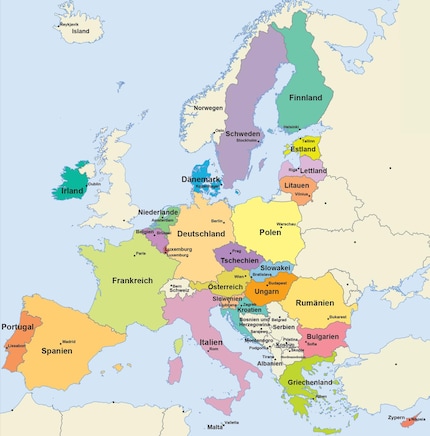
Background information
What is the Digital Services Act?
by Florian Bodoky

The Digital Networks Act is due to come into force in the EU in 2026 in order to harmonise Europe’s network infrastructure rules. But what are the specifics? Read on to find out.
The 27 member states of the European Union all have their own laws. However, EU-wide rules exist in certain areas to ensure greater uniformity among the member states. One example is the European Electronic Communications Code (EECC) – the EU’s telecommunications constitution. It regulates the legal framework for all electronic communications services such as mobile communications, the internet, telephone services and others. However, the EECC dates back to 2018, when 5G, fibre optics and cloud infrastructure were only emerging, and the global political situation was different. That’s why it’s set to be replaced by the Digital Networks Act (DNA).

The DNA aims to establish standardised rules across the EU for all telecommunications – from technologies such as fibre optics, 5G/6G and cloud services to regulations regarding the market and infrastructure security. The DNA is divided into three sub-areas:
This is the technical foundation of the DNA – promoting and harmonising network expansion. In other words, making it faster, more secure and more sustainable. The aim is to achieve this by getting rid of the patchwork of local rules, reducing bureaucracy and implementing construction plans more quickly. The latter includes replacing all copper cables with fibre optics as soon as possible. In fact, providers can be forced to switch off outdated technologies as soon as the replacement technology is available. In addition, the DNA will coordinate the allocation of radio frequencies for satellites as well as 5G and 6G, so that national borders don’t stand in the way of innovations.
The overarching goal is digital sovereignty. The EU wants to design, operate and secure its own digital infrastructure and become as independent as possible from global corporations and third countries such as the USA or China.
As with the Digital Markets Act, the EU’s intention with the DNA is to prevent monopolies or generally dominant market positions. This includes establishing guidelines that define the conditions under which dominant suppliers must grant other market participants access to their networks. Another important aspect is the so-called fair-share principle, which is highly controversial. It stipulates that large online platforms such as Google or Netflix will have to pay a portion of the network infrastructure costs in future. Last but not least, the Body of European Regulators for Electronic Communications (BEREC) is to be strengthened and a uniform EU-wide arbitration system introduced in order to resolve conflicts more efficiently and transparently.
The third area is about the users. The DNA is intended to ensure that everyone in the EU has access to a stable and affordable internet connection. In addition, clear EU-wide rules are to be established for contracts with providers as well as for switching providers. Furthermore, price information for a service must be transparent and must not contain any hidden costs that are not comprehensible to non-experts. The DNA also aims to guarantee that critical infrastructure is protected. For example, submarine cables are to be protected against sabotage and sensitive data should be encrypted accordingly. Emergency plans must also be in place in the event of major network disruptions.
There are many differences between the EECC and the DNA. Let’s start with the legal form. While the EECC is a directive, the DNA is a regulation. The former is a rough framework that each country can implement individually in accordance with its own laws, while a regulation applies throughout the EU and is much more restrictive in terms of implementation. Another difference is the focus on technology: while the EECC focused on copper and 4G, the DNA is about 5G/6G and satellites. The aspects of security and sustainability are also much more important than they were in 2018. The fair-share principle is new, as is the idea of internet access as a fundamental digital right.
The loudest voices in favour of the Digital Networks Act come from European telecoms companies and, of course, the European Commission itself. Europe’s largest network operators, such as Deutsche Telekom, Orange from France, Vodafone and others, see the DNA as an opportunity to adjust market and competition conditions, as national restrictions will be removed. The EU also supports the DNA – not least because it will make it more difficult for non-European companies or governments to influence individual EU members. BEREC is also a major advocate, as cooperation between countries will become significantly more efficient, agile and predictable.
Another argument put forward by proponents is the call for fairness towards network operators. Large online platforms and streaming services such as Google, Meta and Netflix generate enormous amounts of data, but so far don’t bear any direct costs for the infrastructure. With the fair-share principle, many telecommunications companies want to ensure these big players also contribute to the financing of networks in future. Not as a punishment, but as a fair compensation. If you use the network, you should also contribute to its maintenance.

Opponents of the Digital Networks Act see things differently. They’re warning that the DNA in its current form poses more risks than opportunities. Leading the charge are big companies such as Google, Meta, Amazon and Netflix. For them, the DNA is primarily an attack on the principle of net neutrality.
The proposal that large services – which generate a correspondingly high volume of traffic – should contribute to network costs could lead to a two-tier internet structure. In other words, paying companies would be given priority on the network. Others would then have to make do with less bandwidth, which would slow down their services. In an open letter, organisations warned against a «more expensive and inefficient infrastructure with poorer quality of service and higher costs». Consumer protection advocates also see the danger that costs and regulatory pressure could ultimately be passed on to users. Let’s say Netflix, for example, had to contribute to the expansion of the infrastructure. It might raise its fees or cut back on its service to save money.
Smaller providers are also critical of the DNA. They fear it will mainly benefit large network operators by relaxing their obligations and further consolidating their market power. If, for example, access to existing infrastructure is less strictly regulated than before, smaller providers could be forced out of the market. This, in turn, would lead to contradictory overlaps with other EU laws – such as the Digital Services Act (DSA) and the Digital Markets Act (DMA).
In short, while supporters see the DNA as an opportunity for a stronger, sovereign Europe, opponents fear that it will further increase market concentration and the market power of the big players.
In spring 2025, the European Parliament published an initial briefing on the DNA. This was followed in summer 2025 by an official Call for Evidence, which meant a second round of feedback from market participants. The goal was to flesh out the proposals from the Whitepaper, the DNA’s strategic document, and to examine the impact they might have.
As of today, the EU Commission’s official DNA proposal is scheduled to be presented on 16 December 2025. The political work will then begin in 2026: the Council, Parliament and Commission will enter into so-called trilogue negotiations to agree on the final text of the legislation. If everything goes according to plan, the Digital Networks Act could come into force in 2027 – not immediately, but gradually over several months (up to two years). Only then would it replace the old telecoms regulations, the EECC.
I've been tinkering with digital networks ever since I found out how to activate both telephone channels on the ISDN card for greater bandwidth. As for the analogue variety, I've been doing that since I learned to talk. Though Winterthur is my adoptive home city, my heart still bleeds red and blue.
Interesting facts about products, behind-the-scenes looks at manufacturers and deep-dives on interesting people.
Show all